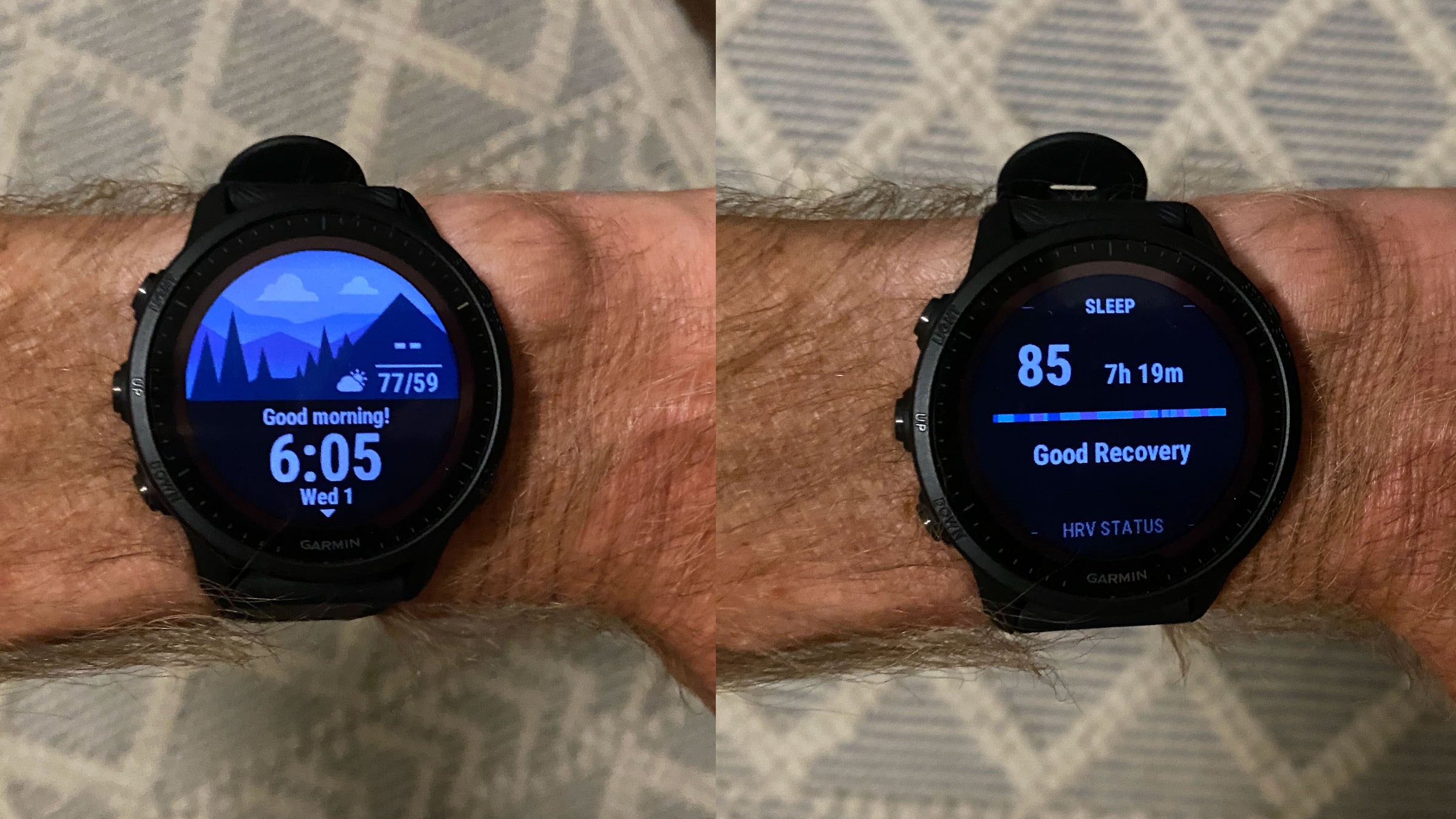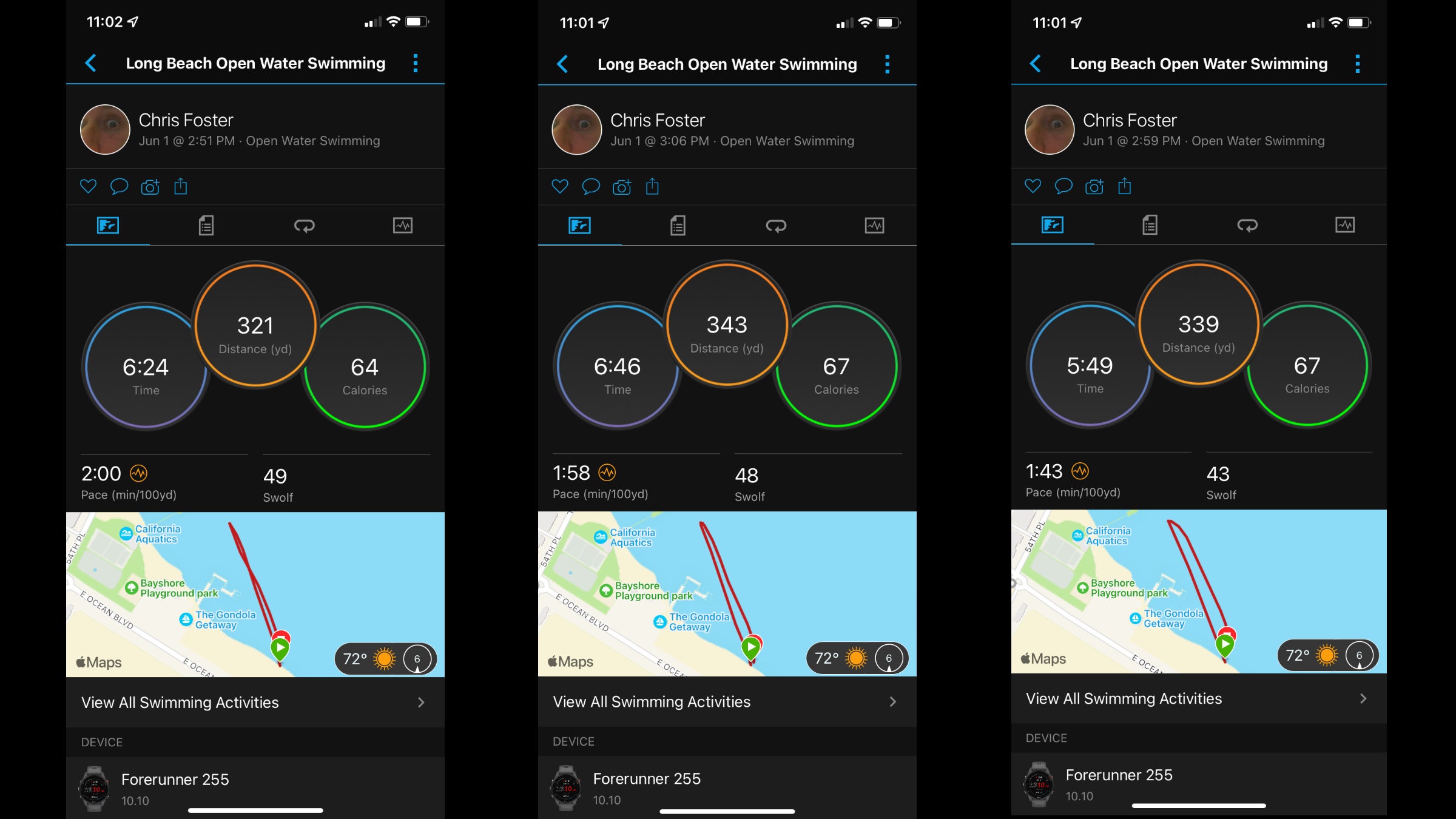New perk! Get after it with local recommendations just for you. Discover nearby events, routes out your door, and hidden gems when you sign up for the Local Running Drop.
Do a quick search on Triathlete’s website for “Garmin Forerunner 245.” You’ll come up with no reviews. Why is that? Let me explain: While the Forerunner 245/245 Music was a fine watch, it was missing two big things that triathletes—by definition—need when they’re working out (in my opinion anyway). If you’re a triathlete and you’re going to spend $300 on a smartwatch—and not everyone wants to/can, I understand—you’re going to want an open-water swimming function. At the very least, you need a “triathlon” or fully-featured “multisport” activity profile that can track your race from start to finish. We’ve never reviewed the 245 because it didn’t have open-water swimming, and while we have reviewed other watches that don’t have open-water swimming, they haven’t been $300 either.
But guess what? Garmin finally got our interest by releasing the much-upgraded 255 this week, so we’re going to take a deep dive into why this is a game changer, not just for the Forerunner 2xx series, but for Garmin and the smartwatch market as a whole.
RELATED: How to Choose the Best Smartwatch for Triathletes
Section dividerGarmin Forerunner 255: What’s New
While we’ll get into an in-depth tri-specific features rundown below, first, it’s important to take a quick look at what’s notably new with the 255, as the upgrade is definitely the big news for triathletes:
Double Battery Life – The 245 was grossly underpowered at 7 days smartwatch/24 hours GPS—making it a tough sell to those of us who work out twice a day, at least five days per week. The 255 comes in at a burly 14 days smartwatch/30 hours GPS—precisely what you’d expect for $350
~17% More Expensive – Yes, while the Forerunner 955 actually came down in price, the 255 went up by $50 for its initial release compared to the original price of the 245. Not a big deal, given the upgrades, but worth noting.
Morning Report – Each morning, the 255 (and the 955) will give you a pretty screen with your name, weather report, sleep report, recovery time, training status, and (surprisingly at this pricepoint) HRV status. Yes, it’s a bit of a novelty, but it’s a big step in keeping the unit on your arm at all times and making it more than just a workout watch.
(UPDATED 11/22) On-Wrist Running With Power – Trail runners and triathletes who need help pacing hilly run courses should rejoice as Garmin finally adds the on-wrist running with power metric to a few models without the need for a pod of some kind. Joining brands like Coros, Polar, and Apple, this measurement is a far more objective way to measure actual effort—especially on hills.
(UPDATED 11/22) Grade-Adjusted Pace – Similar to the running with power metric above, grade-adjusted pace recalibrate your current running pace to account for the presence of hills and estimates (yes, it’s a loose estimation) what that effort actually translates into pace.
Multisport, Triathlon, and Open-Water Activity Profiles – This is huge. For me, this was always a big dealbreaker on even considering at the $300 Forerunner 245. Not only do you get totally essential open-water and tri race modes, but the multisport mode allows you to do bricks or non standard multisport events by switching sports mid activity. Oddly enough, it doesn’t have Swimrun, while the 955 does. ¯\_(ツ)_/¯
Multiband, Multi-System GPS – This is one of those features that might not turn heads, but in reality it’s a pretty big deal at this pricepoint. We see this play out the best when testing open-water swim accuracy (read on below for more).
Garmin Pay, Native Running With Power Display – Contactless payment is cool, and being able to display running power without an extra (clunky) app is great, but both require a greater investment in the Garmin world. Obviously you have to enter your credit card info to use Garmin Pay and very disappointingly, the native running with power only works with their Running Dynamics Pod or HRM-Pro units. No Stryd support (yet) nor on-wrist power sensing (though my understanding is that it’s not even remotely outside the realm of their current built-in smartwatch tech).
Race Prep Info – Sadly this neat feature that counts down days until race day, shows weather at the race site, and gives you a predicted race time only works with cycling and running right now, but it’s a cool idea for your next half marathon anyway.
RELATED: Reviewed: Garmin Forerunner 955 Smartwatch
Section dividerGarmin Forerunner 255: The Features
Below we’ve listed the top triathlon-related features in the Forerunner 255 that weren’t necessarily covered above:
Swimming – The Forerunner 255 has both pool swimming—with all necessary metrics like lengths, distance, pace, stroke count, SWOLF score, and calories, as well as stroke detection—and open-water swimming with the same metrics (minus lengths and stroke detection). It also does a fairly accurate job of detecting heart rate while swimming, but I wouldn’t count on hardly any wrist-based heart-rate monitors when it comes to accuracy.
Cycling – Though many triathletes might not choose to use the Forerunner 255 as a cycling computer, it does all of the standard speed, pace, distance stuff, plus power meter compatibility, though none of the advanced cycling dynamics (like L/R balance) you’d find on a watch like the Forerunner 955.
Running – As noted before, the Forerunner 255 does display running dynamics like power, vertical oscillation, ground-contact time, etc. natively, but it does still (sadly) require one of the two Garmin running dynamics products right now (I’ve been told this could change).
Multisport/Triathlon – Covered above, but worth noting that while there are no “brick” or swimrun programs, you can create your own using the multisport activity as you go.
Training Status, Load, Effect, Performance Condition (running) and Recovery Time – Though each of these metrics are separate, they offer a good (and usable) picture of how well your training is going and how much fatigue you’re experiencing. Garmin does a great job of presenting this information at the right time and in an actionable manner.
Pace Pro – Though this is only available in the running feature, a savvy triathlete can use this surprisingly effective tool to pace the run leg of their next tri—taking into account negative or positive splits, terrain, and more.
Music – The $400 Forerunner 255 Music has 4GB of space for downloaded mp3s or (more likely) downloaded Spotify or Amazon Music playlists that you can listen to with Bluetooth-compatible headphones. Garmin says you’ll get 6.5 hours of music-plus-GPS tracking, which isn’t bad. The base 255 will still control your smartphone music remotely.
Section dividerGarmin Forerunner 255: What We Like
A lot. This is one of the most well-rounded smartwatches I”ve seen Garmin release without a wallet-puckering price tag. No, the base version doesn’t have music (though inscrutable it does have 4GB of storage anyway…figure that one out), and no it doesn’t have mapping (like the 945/955) or a touchscreen (like the 955 or the new Fenix 7/Epix), but it does have just about everything else.
In fact, when you look at the new $500 Forerunner 955 alongside the $350 Foreunner 255, it’s tough to justify another $150 for nothing more than maps, music, and a touchscreen. Even in terms of form factor, it’s nearly impossible to tell the 955 and 255 apart—except that the 255 comes in two case sizes (41mm for the 255S and 46mm for the 255) with multiple color options. Otherwise, I dare you to tell the 3g difference between the 255 Music and the 955.

When looking at the new features like multisport and triathlon mode, there are no issues, as both perform well. Same with the very novel morning report, which I liked much more than I thought I would (kind of reminds me of Polar’s really good morning report…). Here I think Garmin helps themselves a lot by moseying up to more lifestyle-angled brands like Suunto or Apple.

In terms of open-water swimming accuracy, I had my doubts, as a “budget” smartwatch can sometimes not be as accurate as its more expensive cousins, but in my tests over the same course with multiple swims (and good sighting), there was an exceptionally tight grouping when it came to accuracy—which is about as good as you can expect from open-water accuracy.

I also really did like the race calendar countdown for running races (I didn’t get a chance to try it for cycling). Showing how many days until the race, the weather report for race morning, and a predicted race time (as discouraging as it was for me) is pretty cool. However, I’ll talk about the limitations on that feature below.

Finally, for $350, 14 days smartwatch/30 hours GPS is entirely appropriate. While I would have preferred to see the 255 priced at $300 to take a real shot at the $200 Coros Pace 2—still the best deal in town for triathletes, in my opinion—it fares well against similar competition like the Polar Vantage M2 and the Suunto 5 Peak. And yes, you can do a lot more using the Connect smartphone app than you used to be able to (like set up data screens and enter text, thank goodness), so you’re not stuck tapping buttons through endless menus all day.
RELATED: Face Off: Two Midrange Smartwatches, Suunto 5 Peak and Garmin Instinct 2
Section dividerGarmin Forerunner 255: What Could Be Better
I had a hard time finding an issue with the new Forerunner 255, aside from the fact that I would have rather seen it offered at $300 (or less) to start. But given its performance metrics and recovery data, like HRV, that seems a bit like wishing.
Elsewhere, I’d nitpick that this current release (knowing it could very well come in upcoming software updates) is that the race calendar function is limited to running or cycling, when obviously triathletes would love triathlon race or multisport event support. I understand it’s probably a bit more complicated than running or cycling, but even if it was only supported in a basic function (weather and countdown, no training analysis), that would be a start. On that note, even when using the running race calendar function, it’s pretty tough to figure out how to set up for the first time. But of course labyrinthine menus and tough-to-navigate user interfaces are a sad side effect of Garmin’s insane feature list. Other brands might be easier to use, but not many other brands have as much…stuff…as Garmin.
Section dividerGarmin Forerunner 255: Conclusions
This is a great release, and a long time coming for triathletes who were once forced to buy the $500 Forerunner 745 if they wanted open-water and tri functions (RIP Forerunner 6xx and 7xx series, for sure). Finally triathletes don’t have to go super premium to get on the Garmin bandwagon, but it also does serve notice to some of their competitors like Polar, Suunto, and (kind of) Coros. With the release of the surprisingly multisport-capable Instinct 2 earlier this year, a bump up in the midrange Forerunner line seemed inevitable.
If you’ve been waffling on buying a new smartwatch, and you’re really hooked on Garmin’s exhaustive feature list, this is the one to pounce on. There are other smartwatches that might do 90% of what you need for the same price or less, but I can’t think of a single smartwatch for under $400 that has all of these functions in a totally appropriate size and battery capacity. Want more battery life for the same amount of money? Go with the Coros Apex—but don’t expect nearly as many features (or music control for that matter)—or the Garmin Instinct 2 (one of my favorites this year), but be ready to squint at a tiny black-and-white screen. Otherwise, Garmin has finally hit the nail on the Forerunner head.
